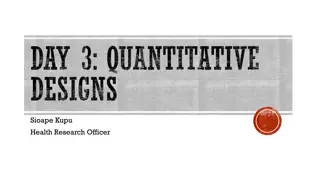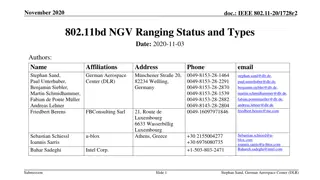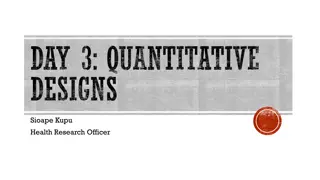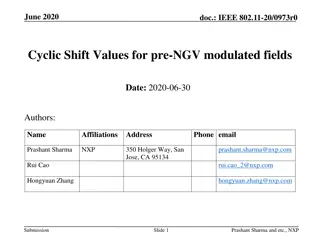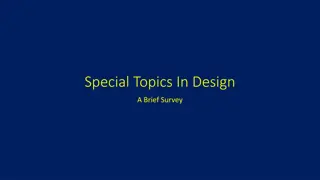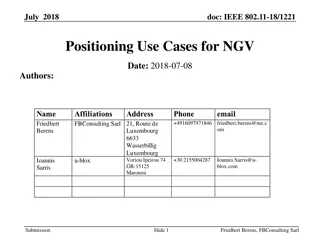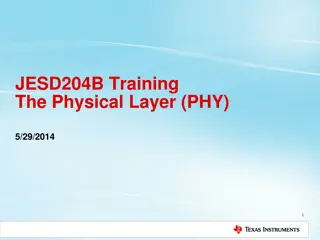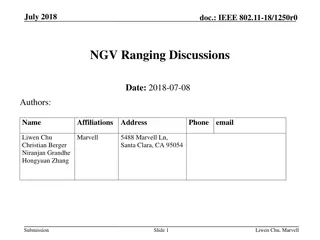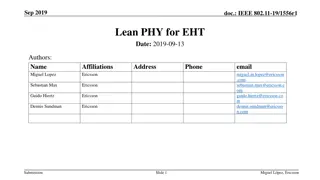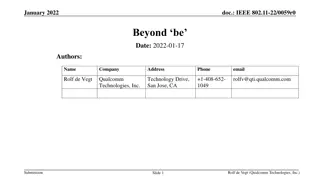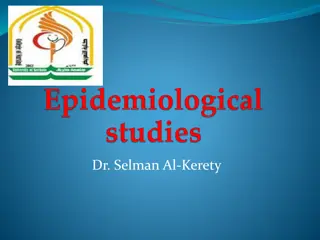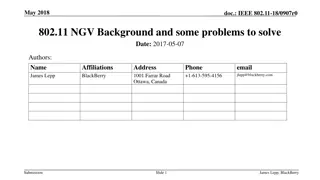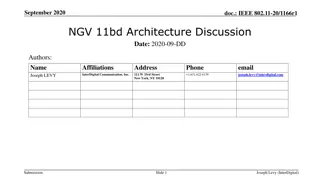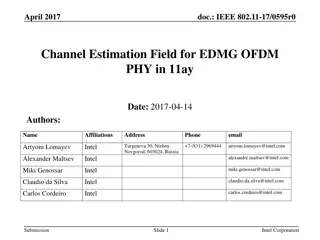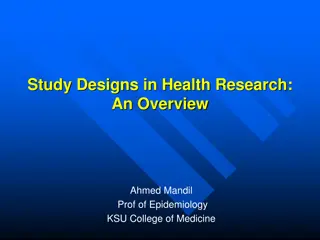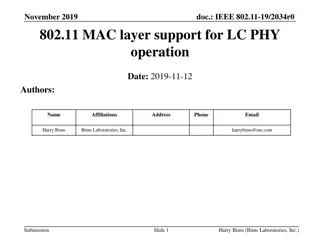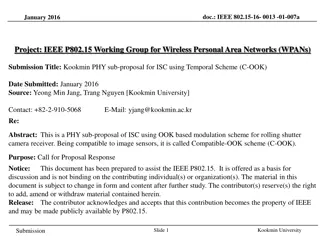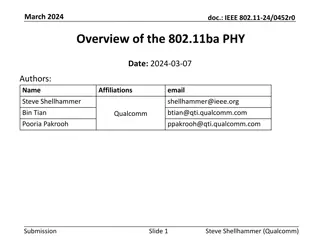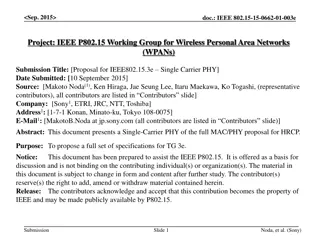
Enhancing PHY Designs for Next-Generation Vehicles
Discover potential PHY designs for next-generation vehicles (NGV) as per IEEE 802.11-19/0016r0 document in January 2019. Explore advanced technologies such as OFDM Numerology, LDPC coding, Midamble techniques, and Higher QAM to achieve higher throughput and sensitivity goals. Gain insights into OFDM tone spacing, symbol durations, and efficient OFDM plans for improved performance. Dive into detailed simulations of DSRC channels, LDPC coding, Doppler channel models, and OFDM numerology variants. Experience the evolution of WLAN standards and the promising advancements in 802.11 technologies for NGV applications.
Download Presentation

Please find below an Image/Link to download the presentation.
The content on the website is provided AS IS for your information and personal use only. It may not be sold, licensed, or shared on other websites without obtaining consent from the author. If you encounter any issues during the download, it is possible that the publisher has removed the file from their server.
You are allowed to download the files provided on this website for personal or commercial use, subject to the condition that they are used lawfully. All files are the property of their respective owners.
The content on the website is provided AS IS for your information and personal use only. It may not be sold, licensed, or shared on other websites without obtaining consent from the author.
E N D
Presentation Transcript
January 2019 doc.: IEEE 802.11-19/0016r0 Potential PHY Designs for NGV Date: 2019-01-14 Authors: Name Affiliations Address Phone email Rui Cao Marvell 5488 Marvell Ln, Santa Clara, CA 95054 ruicao@marvell.com Hongyuan Zhang hongyuan@marvell.com Prashant Sharma psharma@marvell.com Submission Slide 1 Rui Cao and etc., Marvell
January 2019 doc.: IEEE 802.11-19/0016r0 Introduction NGV PAR specifies the goal of achieving 2x throughput and 3dB better sensitivity [1]. WLAN standard has evolved after 11p, adopting many advanced technologies (e.g. LDPC, Midamble, etc) to gain higher throughput and better reliability. 802.11bd can leverage the evolution of the 802.11 technologies to achieve the goal. In this contribution, we investigate the promising PHY technologies for 802.11bd. Submission Slide 2 Rui Cao and etc., Marvell
January 2019 doc.: IEEE 802.11-19/0016r0 Candidate PHY Designs OFDM Numerology Leverage mature 802.11ac OFDM numerology to achieve better OFDM efficiency than 11p FEC Coding: LDPC LDPC achieves prominent SNR gain over convolutional codes (BCC) Midamble Midamble is an effective technique adopted in 802.11ax to mitigate Doppler impact. Higher QAM Higher QAM is the low-hanging fruit to boost peak throughput. NGV 20MHz PPDU 2x throughput can be achieved by introducing 20MHz PPDU. Submission Slide 3 Rui Cao and etc., Marvell
January 2019 doc.: IEEE 802.11-19/0016r0 OFDM Numerology OFDM tone spacing: f f >> maximum Doppler frequency fd to guarantee low Inter-carrier- interference (ICI) level [2]. OFDM symbol duration = 1/ f. The longer symbol duration, better OFDM efficiency is achieved (fixed cyclic prefix (CP) duration) But more channel variation from the training symbol will be observed. OFDM tone plan 802.11ac OFDM tone plan achieves better OFDM efficiency than 11a. For example, SigBW=10MHz, CP=1.6us OFDM Numerology NFFT NSD Tone spacing Downclock Ratio Efficiency 11a/g 20MHz 64 48 156.25kHz 2 60% 11ac 20MHz 64 52 156.25kHz 2 65% 11ac 40MHz 128 108 78.125kHz 4 75% 11ac 80MHz 256 234 39.0625kHz 8 86% Submission Slide 4 Rui Cao and etc., Marvell
January 2019 doc.: IEEE 802.11-19/0016r0 Simulations Simulation settings 10MHz DSRC channel 1x1, 1SS 11ac LDPC coding Midamble: uses VHT-LTF Number of data bits: 1000 Bytes CFO: uniformly distributed between [-20, 20]ppm Ideal timing Car2Car Doppler channel model [3] 11ac OFDM numerology: 20MHz downclock by 2 40MHz downclock by 4 80MHz downclock by 8 Submission Slide 5 Rui Cao and etc., Marvell
January 2019 doc.: IEEE 802.11-19/0016r0 OFDM Numerology: Highway NLOS NGV-11ac-OFDM, CH:Highway NLOS, Midamble:2 symbols, 1000Bytes 0 10 -1 10 PER BPSK-1/2 QPSK-1/2 16QAM-1/2 16QAM-3/4 64QAM-3/4 64QAM-5/6 256QAM-3/4 11ac 20MHz DC2 11ac 40MHz DC4 11ac 80MHz DC8 -2 10 -3 10 0 5 10 15 20 25 30 35 40 SNR (dB) In high Doppler channel: 11ac 20MHz DC2 is a good candidate for all MCS with dense Midamble. Submission Slide 6 Rui Cao and etc., Marvell
January 2019 doc.: IEEE 802.11-19/0016r0 OFDM Numerology: Highway LOS NGV-11ac-OFDM, CH:Highway LOS, Midamble:4 symbols, 1000Bytes 0 10 -1 10 BPSK-1/2 QPSK-1/2 16QAM-1/2 16QAM-3/4 64QAM-3/4 64QAM-5/6 256QAM-3/4 11ac 20MHz DC2 11ac 40MHz DC4 11ac 80MHz DC8 PER -2 10 -3 10 0 5 10 15 20 25 30 35 40 SNR In medium Doppler channel: 11ac 20MHz DC2 is a good candidate for all MCS with medium Midamble period Slide 7 Submission Rui Cao and etc., Marvell
January 2019 doc.: IEEE 802.11-19/0016r0 OFDM Numerology: Rural LOS NGV-11ac-OFDM, CH:Rural LOS, Midamble:8 symbols, 1000Bytes 0 10 -1 10 BPSK-1/2 QPSK-1/2 16QAM-1/2 16QAM-3/4 64QAM-3/4 64QAM-5/6 256QAM-3/4 11ac 20MHz DC2 11ac 40MHz DC4 11ac 80MHz DC8 PER -2 10 -3 10 0 5 10 15 20 25 30 35 40 SNR In low Doppler channel: 11ac 20MHz DC2 is a good candidate for all MCS with sparse Midamble Slide 8 Submission Rui Cao and etc., Marvell
January 2019 doc.: IEEE 802.11-19/0016r0 FEC Coding LDPC has been introduced to WiFi since 802.11n. Prominent coding gain is achieved compared with BCC in 802.11a [4]. It is the low-hanging fruit for 802.11bd to achieve better sensitivity by adopting LDPC codes. The same LDPC code design as 802.11n/ac can be used. Submission Slide 9 Rui Cao and etc., Marvell
January 2019 doc.: IEEE 802.11-19/0016r0 Midamble In 11p, no Doppler mitigation techniques are standardized at the transmitter. For applications with short messages (Basic Safety Message(BSM)), the decoder may tolerate low-to-medium Doppler for low MCS. Receiver DFE-based tracking can also help in high-Doppler environments, but it is limited due to implementation complexity. Midamble is a simple and effective technique to address Doppler It has been standardized in 802.11ax for outdoor applications. The midambles are training symbols that are inserted in-between data symbols for the receiver to update the channel along the packet. Submission Slide 10 Rui Cao and etc., Marvell
January 2019 doc.: IEEE 802.11-19/0016r0 Midamble Design L Data Symbols Midamble M Data Symbols M Data Symbols Midamble Preamble NGV LTF In a NGV frame with Midamble, the Midamble field can be the same as NGV LTF. The midambles are inserted periodically, every M data symbols. Channel update based on Midabmles can limit the channel variation/aging of Doppler channel with the Midamble period. Midamble period can be determined based on channel Doppler. Submission Slide 11 Rui Cao and etc., Marvell
January 2019 doc.: IEEE 802.11-19/0016r0 NGV vs 11p: Sensitivity (Highway NLOS) NGV-vs-11p, CH:Highway NLOS, QPSK-1/2, 300Bytes 0 10 11p 11ac 20MHz DC2, LDPC+Midamble4 -1 10 PER -2 10 -3 10 0 2 4 6 8 10 SNR(dB) 12 14 16 18 20 22 In high-Doppler channel: NGV can achieve 2.5dB SNR gain with LDPC and Midamble for QPSK-1/2. Slide 12 Submission Rui Cao and etc., Marvell
January 2019 doc.: IEEE 802.11-19/0016r0 NGV vs 11p: Sensitivity (Highway LOS) NGV-vs-11p, CH:Highway LOS, QPSK-1/2, 300Bytes 0 10 -1 10 PER -2 10 11p 11ac 20MHz DC2, LDPC+Midamble4 -3 10 0 2 4 6 8 10 12 SNR(dB) In medium-Doppler channel: NGV can achieve 1.7dB SNR gain with LDPC and Midamble for QPSK-1/2. Submission Slide 13 Rui Cao and etc., Marvell
January 2019 doc.: IEEE 802.11-19/0016r0 NGV vs 11p: Sensitivity (Rural LOS) NGV-vs-11p, CH:Rural LOS, QPSK-1/2, 300Bytes 0 10 -1 10 PER -2 10 11p 11ac 20MHz DC2, LDPC+Midamble4 -3 10 0 1 2 3 4 5 6 7 8 9 SNR(dB) In low-Doppler channel: NGV can achieve 1.5dB dB SNR gain with LDPC and Midamble for QPSK-1/2. Slide 14 Submission Rui Cao and etc., Marvell
January 2019 doc.: IEEE 802.11-19/0016r0 Higher QAM Higher than 64 QAM modulation schemes are standardized since 802.11ac. Higher QAM can simply increase the peak throughput. With the help of Midamble, channel aging is constrained within each Midamble period. Higher QAM can be supported for NGV. Higher QAM can offset the efficiency loss due to Midamble airtime. One good candidate is 802.11ac 256QAM with coding rate . Submission Slide 15 Rui Cao and etc., Marvell
January 2019 doc.: IEEE 802.11-19/0016r0 NGV vs 11p: Tput (Highway NLOS) 10MHz thoughput: NGV vs 11p, CH:Highway NLOS 25 20 15 Tput (Mbps) 10 5 11p 11ac LDPC+Midamble 0 0 5 10 15 20 25 30 35 40 SNR (dB) In high-Doppler channel: >2 times peak throughput gain can be achieve with LDPC + Midamble + 256QAM. Slide 16 Submission Rui Cao and etc., Marvell
January 2019 doc.: IEEE 802.11-19/0016r0 NGV vs 11p: Tput (Highway LOS) 10MHz thoughput: NGV vs 11p, CH:Highway LOS 35 30 25 Tput (Mbps) 20 15 10 5 11p 11ac LDPC+Midamble 0 0 5 10 15 20 25 30 35 40 SNR (dB) In medium-Doppler channel: 20% peak throughput gain can be achieved with LDPC + Midamble + 256QAM. Slide 17 Submission Rui Cao and etc., Marvell
January 2019 doc.: IEEE 802.11-19/0016r0 NGV vs 11p: Tput (Rural LOS) 10MHz thoughput: NGV vs 11p, CH:Rural LOS 35 30 25 Tput (Mbps) 20 15 10 5 11p 11ac LDPC+Midamble 0 0 5 10 15 20 25 30 35 40 SNR (dB) In low-Doppler channel: ~30% peak throughput gain can be achieved with LDPC + Midamble + 256QAM. Slide 18 Submission Rui Cao and etc., Marvell
January 2019 doc.: IEEE 802.11-19/0016r0 DSRC Channel Usage 5850 MHz 5925 MHz CH 175 20 MHz CH 181 20 MHz CH 172 CH 174 CH 176 CH 178 CH 180 CH 182 CH 184 5850- 5855 Service Service Service Control Service Service Service Reserve 10 MHz 10 MHz 10 MHz 10 MHz 10 MHz 10 MHz 10 MHz 5 MHz Ch. 172: Collision Avoidance Safety Ch. 178:Control Channel: WAVE Service Advertisements Ch. 184: Public Safety 802.11p defines signal format for 5MHz, 10MHz and 20MHz BW, by using corresponding downclocked version of 11a 20MHz [5]. FCC designates the usage of the 10MHz DSRC channels [6]. 20MHz is not practically used in the fields, and not compatible with 10MHz channels. Submission Slide 19 Rui Cao and etc., Marvell
January 2019 doc.: IEEE 802.11-19/0016r0 NGV 20MHz PPDU Legacy portion 10MHz 20MHz NGV data portion Legacy portion 10MHz 802.11bd can define a new 20MHz PPDU The new 20MHz PPDU occupies two adjacent 10MHz DSRC channels. for example, CH 175 and 181 in US. This format can achieve 2x throughput of 10MHz 11p. Frame format: Legacy portion uses duplicate 10MHz 11p preamble format. 20MHz NGV data portion can use 11ac 20MHz OFDM numerology or 11ac 40MHz DC2 OFDM numerology, etc. Coexist with10MHz DSRC operation, including 11p. 11p receivers can avoid detecting both 10 and 20MHz preamble for CCA. only detect OFDM signal on its own operating 10MHz. Submission Slide 20 Rui Cao and etc., Marvell
January 2019 doc.: IEEE 802.11-19/0016r0 Summary We investigated several PHY techniques for 802.11bd to achieve the goals set in the PAR. 802.11ac 20MHz OFDM numerology is shown as a good choice for 10MHz DSRC channel for its efficiency and Doppler resilience. LDPC and Midamble can be adopted in 802.11bd to achieve substantial SNR gains and Doppler mitigation. 256QAM is a good advance of modulation for throughput boost. NGV 20MHz PPDU is also defined to achieve 2x peak throughput. Submission Slide 21 Rui Cao and etc., Marvell
January 2019 doc.: IEEE 802.11-19/0016r0 Reference [1] Bo Sun and etc., 802.11 NGV SG Proposed PAR , IEEE 802.11- 18/0861r9. [2] Rui Cao and etc., Doppler Impact on OFDM Numerology for NGV , 11- 18/1553 [3] Hongyuan Zhang and etc. C2C Channel Model Overview , 11-18/0858r0 [4] Aleksandar Purkovic, and etc., LDPC vs Convolutional Codes for 802.11n applications performance comparison , 11-04/0071r01. [5] 802.11REVmd, D1.6 [6] John Kenny, DSRC Application Tutorial , 11-13/0541r01. Submission Slide 22 Rui Cao and etc., Marvell
January 2019 doc.: IEEE 802.11-19/0016r0 APPENDIX Submission Slide 23 Rui Cao and etc., Marvell
January 2019 doc.: IEEE 802.11-19/0016r0 OFDM Numerology: Packet Efficiency Packet Efficiency = OFDM efficiency * Midamble efficiency Period 1 20MHz 40MHz 80MHz 2 4 8 0.3250 0.4333 0.5200 0.5778 0.3750 0.5000 0.6000 0.6667 0.4300 0.5733 0.6880 0.7644 Submission Slide 24 Rui Cao and etc., Marvell
January 2019 doc.: IEEE 802.11-19/0016r0 OFDM Numerology: Highway NLOS NGV-11ac-OFDM,Highway NLOS, Midamble 0 10 -1 10 PER BPSK-1/2 QPSK-1/2 16QAM-1/2 16QAM-3/4 64QAM-3/4 64QAM-5/6 256QAM-3/4 11ac 20MHz DC2 M2 11ac 40MHz DC4 M1 11ac 80MHz DC8 M1 -2 10 -3 10 0 5 10 15 20 25 30 35 40 SNR (dB) Submission Slide 25 Rui Cao and etc., Marvell
January 2019 doc.: IEEE 802.11-19/0016r0 OFDM Numerology: Highway LOS NGV-11ac-OFDM,Highway LOS, Midamble 0 10 -1 10 PER BPSK-1/2 QPSK-1/2 16QAM-1/2 16QAM-3/4 64QAM-3/4 64QAM-5/6 256QAM-3/4 11ac 20MHz DC2 M8 11ac 40MHz DC4 M4 11ac 80MHz DC8 M2 -2 10 -3 10 0 5 10 15 20 25 30 35 40 SNR (dB) Submission Slide 26 Rui Cao and etc., Marvell
January 2019 doc.: IEEE 802.11-19/0016r0 OFDM Numerology: Rural LOS NGV-11ac-OFDM,Rural LOS, Midamble 0 10 BPSK-1/2 QPSK-1/2 16QAM-1/2 16QAM-3/4 64QAM-3/4 64QAM-5/6 256QAM-3/4 11ac 20MHz DC2 M8 11ac 40MHz DC4 M4 11ac 80MHz DC8 M2 -1 10 PER -2 10 -3 10 0 5 10 15 20 25 30 35 40 SNR (dB) Submission Slide 27 Rui Cao and etc., Marvell
January 2019 doc.: IEEE 802.11-19/0016r0 PER: Highway NLOS NGV-11ac-OFDM, CH:Highway NLOS, Midamble:2symbols, 1000Bytes 0 10 -1 10 PER BPSK-1/2 QPSK-1/2 16QAM-1/2 16QAM-3/4 64QAM-3/4 256QAM-3/4 11ac 20MHz DC2 11p -2 10 -3 10 0 5 10 15 20 25 30 35 40 SNR In high-Doppler channel: NGV can achieve 3~5dB dB SNR gain at low MCS, and can support up to 256QAM. Slide 28 Submission Rui Cao and etc., Marvell
January 2019 doc.: IEEE 802.11-19/0016r0 PER: Highway LOS NGV-11ac-OFDM, CH:Highway LOS, Midamble:4symbols, 1000Bytes 0 10 -1 10 PER BPSK-1/2 QPSK-1/2 16QAM-1/2 16QAM-3/4 64QAM-3/4 256QAM-3/4 11ac 20MHz DC2 11p -2 10 -3 10 0 5 10 15 20 25 30 35 40 SNR In medium-Doppler channel: NGV can achieve 2~5dB dB SNR gain at low MCS with LDPC and Midamble, and support up to 256QAM. Submission Slide 29 Rui Cao and etc., Marvell
January 2019 doc.: IEEE 802.11-19/0016r0 PER: Rural LOS NGV-11ac-OFDM, CH:Rural LOS, Midamble:8symbols, 1000Bytes 0 10 BPSK-1/2 QPSK-1/2 16QAM-1/2 16QAM-3/4 64QAM-3/4 256QAM-3/4 11ac 20MHz DC2 11p -1 10 PER -2 10 -3 10 0 5 10 15 20 25 30 35 40 SNR In low-Doppler channel: NGV can achieve 2~5dB dB SNR gain with LDPC and Midamble at all MCSs, and support 256QAM. Slide 30 Submission Rui Cao and etc., Marvell

